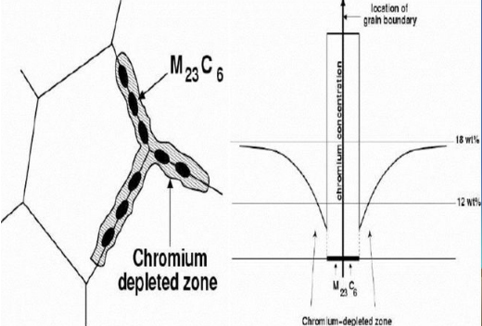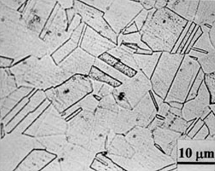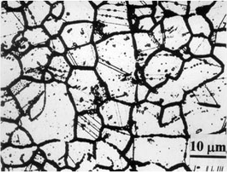Home » News & Articles » What is Sensitization and How to Avoid It?
Sensitization is a phenomenon that can occur in stainless steel and even some nickel alloys. It is a critical concept that needs to be understood as it can adversely affect the performance of stainless steel and nickel alloys.
Sensitization is the precipitation of carbides at grain boundaries that leaves adjacent regions depleted in chromium and susceptible to intergranular corrosion. Sensitization occurs when a material is exposed to a specific range of temperatures for a time sufficient for carbides to form. In the case of austenitic stainless steels, they can commonly become sensitized between 900°F – 1500°F. Sensitization can occur either through operating in this range or slowly cooling through this range. The figure below shows what happens when a material becomes sensitized. Chromium within the grain will navigate to the grain boundary to form carbides, leaving behind a chromium-depleted region adjacent to the carbides.
For stainless steel and nickel alloys to retain a protective chromium oxide layer, the material must have a uniform chromium composition of at least 12%. When sensitization occurs, the chromium-depleted areas will contain less than 12% chromium, leaving the material susceptible to intergranular corrosion. In the most severe cases, intergranular corrosion advances to the point where individual surface grains can physically separate and drop out of the surface of the material. The photographs below show a non-sensitized microstructure on the left and a sensitized microstructure on the right.
Multiple methods have been used across industry to control or minimize the likelihood of sensitization occurring. A few of these methods are discussed below:
– High-temperature solution annealing is performed by heating material to a temperature between 1950°F – 2050°F and immediately quenching. At the process temperature, all grain boundary carbides dissolve into solution. Quenching should be rapid enough to ensure that the carbon stays in solution.
– The addition of strong carbide formers or stabilizing elements such as niobium or titanium results in carbides forming with these elements instead of chromium because they have a greater affinity for carbon. The contents of these alloying elements are calculated so that all carbon is tied up by these elements instead of chromium. Examples of stabilized grades include 321 and 347.
– Another option is to utilize low-carbon stainless steel. Many stainless grades have a low-carbon version, such as 304L and 316L, that restricts carbon to a 0.03% maximum. Restricting carbon to such a low limit minimizes the quantity of carbon available for the precipitation of grain boundary carbides. Low-carbon grades are preferred to avoid sensitization. However, a lower carbon content results in a lower-strength material. Through adjustments, many of the 300 series austenitic stainless steels are dual-certified to meet the low carbon limit and higher strength requirements. In addition to meeting the strength and chemistry requirements, it is common to see an intergranular corrosion test on a material test report, such as ASTM A262 Practice E. This corrosion test starts with a sample that has seen temperatures within the sensitization range and is then submitted for corrosion testing. This ensures that if the material sees elevated temperature during service or welding, it shouldn’t become sensitized.

2026 Trade Show Schedule
Connect with our team in person throughout 2026 at these key industry events. Explore our full trade show schedule to discover where we’ll be exhibiting
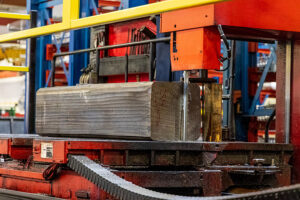
How Titanium Sponge and Scrap Become Final Products
Titanium sponge and scrap are the starting materials for producing titanium ingots and slabs. Through processes like vacuum arc remelting (VAR) and hearth melting, these
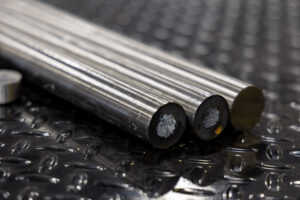
Alloying Elements Explained
Alloying elements play a critical role in shaping the strength, corrosion resistance, and performance of metals. This article breaks down the most common alloying elements,
Never Miss an Update - Subscribe Today!
Get application insights, material guides, and technical answers straight from the leaders in high-performance alloys.
Share:
QUOTE, BUY, TRACK
We make it easy to get instant pricing and purchase your metal at the click of a button. Track your order progress, get notified when it ships, and follow your shipment online until it’s delivered. It’s that easy!
Latest Articles
2026 Trade Show Schedule
Connect with our team in person throughout 2026 at these key industry events. Explore our full trade show schedule to discover where we’ll be exhibiting all year long.
How Titanium Sponge and Scrap Become Final Products
Titanium sponge and scrap are the starting materials for producing titanium ingots and slabs. Through processes like vacuum arc remelting (VAR) and hearth melting, these materials are refined into high-purity forms that are then forged, rolled, and finished into titanium plates, bars, and components.
Alloying Elements Explained
Alloying elements play a critical role in shaping the strength, corrosion resistance, and performance of metals. This article breaks down the most common alloying elements, explains how they affect material properties, and provides guidance for choosing the right alloy for any application.
How the Kroll Process Produces Titanium Sponge
The Kroll process is the primary industrial method for transforming titanium ore into metallic titanium…
RA 253 MA Delivers High-Temp Performance in Industry Feature
Rolled Alloys has been featured in Heat Treat Today with the article, “A Microalloyed Solution for High-Temp Applications.”

